Porcelain Insulator News
by Elton Gish
Reprinted from "Crown Jewels of the Wire", November 1993, page 15
In the August 1989 issue of CJ, we discussed the unusual fog-type M-3900. A
picture of a line was shown that had many of these still in service in Illinois.
I have had a report that the line has been dismantled, which may explain why a
number of these "tick" insulators were being traded earlier this year.
I believe that the insulators on this line had a chocolate brown glaze. The
photographs that I used to illustrate M-3900 in my book, Multipart Porcelain
Insulators, were taken of an older style, which typically has a mottled glaze
characteristic of early Ohio Brass manufacture.
Very few of you have been fortunate enough to have both styles, so the
differences in these insulators has gone unnoticed until recently. Chris Hedges
(NIA #15) sent in the following picture and dimensions so we could finally
assign a new M-number to the chocolate brown styIe. The differences are in the
diameter, height and crown detail. The interior, with the small two-part
insulator cemented inside, remains essentially the same as M-3900. The chocolate
brown insulator is larger and it has been assigned M-3950. The following shows a
comparison of the two styles:

M-3900: 15 - 10.5 - 7.5 - 3.5 x 8 (right)
M-3950: 15.5 -10.5 - 7.5 - 3.5 x 9 (left)
Chris also sent the following photograph of a very pretty M-3156A. In the
photograph, you may be able to see the marking across the side of the crown. It
is the Old English style PITTSBURG marking, perfectly struck in the crown! The
top skirt has a beautiful light, reddish tan glaze with interesting dark
mottling. The color of the lower skirts gets progressively darker mahogany. I
was fortunate to get the unmarked brother to Chris' insulators, and it is
equally attractive. These two insulators were found near Bryce Canyon, Utah.
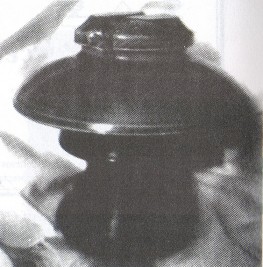
M-3156A with Old English
PITTSBURG marking, on side of crown.
The Denver National was the best National show that I have ever been to. The
small details and the "aim-to-please" attitude of the show hosts made
the show very special, and the world class displays were the finishing touch.
There was a lot of good porcelain there, too. It was such a great show, that I
completely forgot to take a picture of the following insulator. I want to thank Bill
Rohde (NIA # 1219) for sending the two pictures.
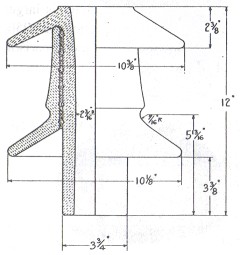
Dead end spool shown in the
1916 Ohio Brass catalog.
Mike Miller brought three very
unusual insulators to the Denver National which had beautiful light orange tan
glazes. These are dead end spools used to tie-off the end of a power line or to
turn sharp comers where there is a lot of stress and tension from the power
line. Mike said that there were five of these found, but he was only able to get
three of them. Deadends with this nicely colored glaze are hard to find. Most
that I have seen were a rather ugly dark brown. What makes these super pieces
(besides the great color) is the deep incuse marking on the bottom skirt. This
previously unreported marking is quite clear in the photograph.
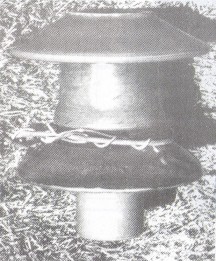 |
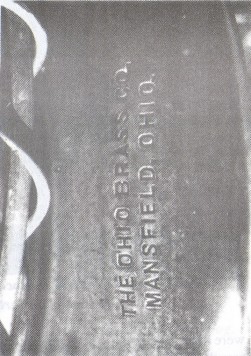 |
|
Ohio Brass deadend spool and impeccable embossing. |
Ben Kirsten was at the
Denver National and told me about a couple of 3-part Fred Locke insulators in his
collection, as well as his great collection of 2-part porcelain suspension disks.
Bill Rohde could not resist checking out a potential new multipart insulator, so
he stopped by Ben's house recently. Bill sent in the following great photos.
Indeed, Ben's insulator is a NEW Fred Lock multipart. It has been temporarily
assigned M-3236, because the height could not be accurately measured. There is a
huge metal piece cemented to the crown, which was used to clamp to and support
some type of electrical equipment. It has either a 6-date or 7-date Fred Locke
marking on the top skirt. The glaze is a nice light tan. The bottom skirt is
very bubbly, which indicates that the porcelain was not of very good quality,
and no doubt very porous from the imperfections. This is the first report of
this insulator style, and there are no known 3-part Fred Locke styles that come
close to it, except for the one lone crude specimen of M-3060 with the #7-1
marking. It was made circa 1903-1904.
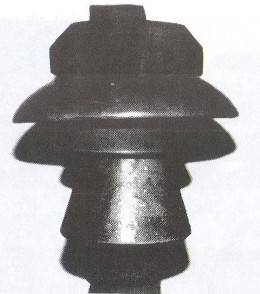
Fred M. Locke M-3236
The dimensions are: 10 - 7 - 7 x 10
In the November 1991 issue of CJ, we showed
various types of early suspension insulators that were made based on the John
Duncan patent No. 880,203 (1908). Many of these early Duncan style suspension
disks were made by cementing two pieces together. Ben sent a nice drawing of one of
his two-piece suspension disks, which we ran in the November 1991 issue. I
believe that Ben told me that he had three different two-piece suspension disks. Bill took the
following two photographs, which show close-up views of the inner skirt on two of Ben's suspensions.
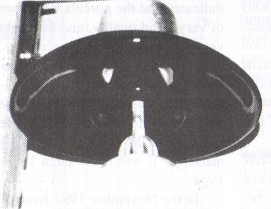 |
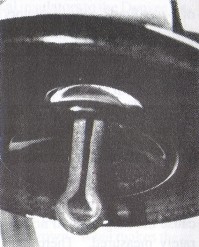 |
| Close-up views of two-piece suspension disks. The one on the left is an
unmarked Thomas and the one on the right is marked with the VICTOR R=oo
insulator logo. |
These insulators
must be very rare because the cement joints were known to have caused a lot of problems. Expansion of the cement during hot
weather would often break the porcelain, and the cap and pins were frequently
being pulled out due to the weight and stress of the conductor, especially in
high winds.
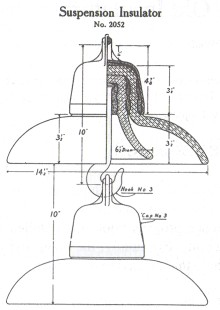 |
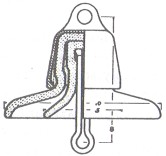 |
| From 1915 Thomas catalog. |
From 1913 Locke catalog. |
Many patents were granted over the years for ideas to eliminate these
problems. The Hewlett suspension disks remained popular for many years, until
the lighter and simpler cap and pin suspension disks were perfected.
| 